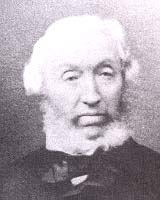Anthony Salvin
Anthony Salvin (born October 17, 1799 in Sunderland Bridge , County Durham , † December 17, 1881 in Fernhurst , Sussex ) was a British architect . The main representative of the Gothic Revival was best known for his reconstructions and restoration work on medieval castles and churches.
After completing his training, Salvin began repairing and restoring older mansions. His first independent commission was from 1826 Mamhead Park in Devon, followed in 1831 by Harlaxton Manor in Lincolnshire. The member of the Society of Antiquaries of London had developed a reputation as an expert in medieval architecture early on and was therefore particularly active in castles and churches. In 1835, he provided Norwich Castle with a new facade and repaired the ruins of Newark Castle in Nottinghamschire and Carisbrooke Castle on the Isle of Wight.
Salvin, during whose working hours monument protection was only beginning to take shape, often restored the buildings to an idealized earlier state. To obtain this, he often tore down historical buildings. During the restoration of the Holy Sepulcher Church in Cambridge, for example, he completely rebuilt the southern nave, tore down the uppermost part of the central tower completely and had it replaced with a conical roof. While working on Norwich Cathedral and Durham Cathedral , he generously rebuilt the 17th century choir stalls to bring them into a medieval state. In the later years of his work, Salvin found himself in an ongoing feud with the Society for the Protection of Ancient Buildings over his demolitions .

Important new buildings by Salvin were Keele Hall in Staffordshire and Thoresby Hall in Nottinghamshire. These buildings were mainly in the style of the Tudor Revival Architecture . The construction of Peckforton Castle near Manchester led to public discussions about the usefulness of recreating medieval castles in the 19th century.
In 1851 Salvin was commissioned to repair the Beauchamp Tower in the fortress of the Towers of London. His work there was so popular that he then renovated the Salt Tower , Wakefield Tower , White Tower and the Church of St. Peter ad Vincula in the fortress. Salvin's neo-Gothic influence was formative enough that even after the end of his active career, John Taylor continued to work in the spirit of Salvin. The success in the Tower in turn brought Salvin the contract to carry out major renovations at Windsor Castle .
Salvin reduced his workload after a stroke in 1857, but did not end his active career until 1879, two years before his death.
literature
- Jill Allibone: Anthony Salvin: pioneer of Gothic revival architecture, 1799-1881. University of Missouri Press, 1987, ISBN 0826206298
Web links
| personal data | |
|---|---|
| SURNAME | Salvin, Anthony |
| BRIEF DESCRIPTION | English architect |
| DATE OF BIRTH | October 17, 1799 |
| PLACE OF BIRTH | Sunderland Bridge |
| DATE OF DEATH | December 17, 1881 |
| Place of death | Fernhurst |

